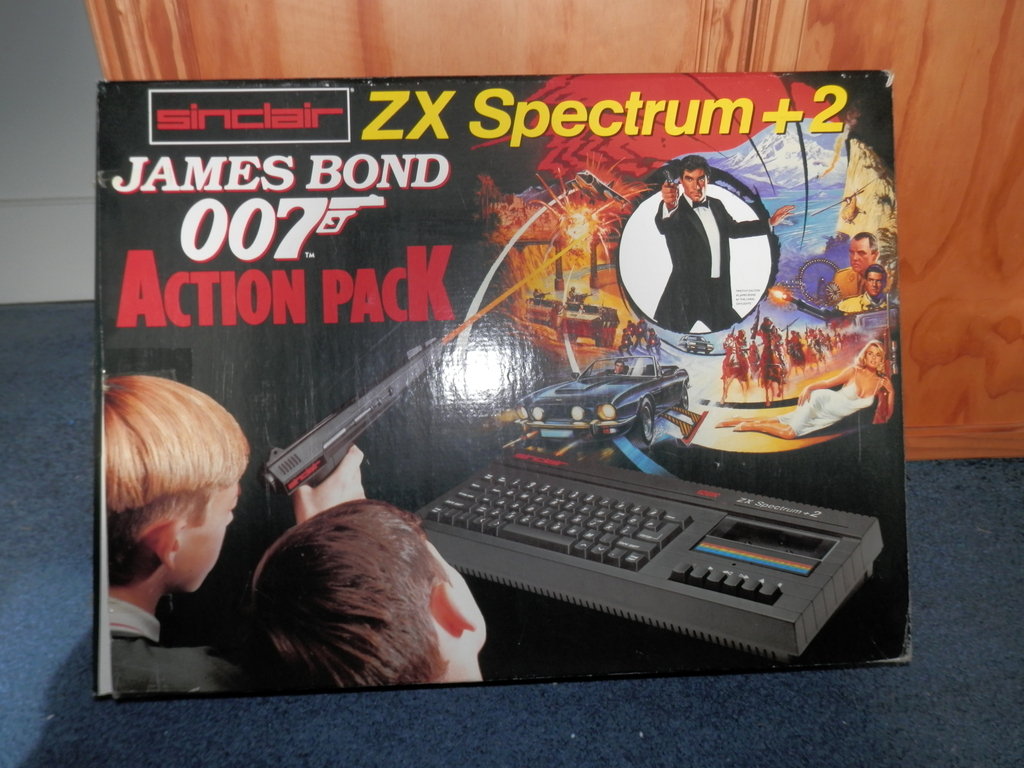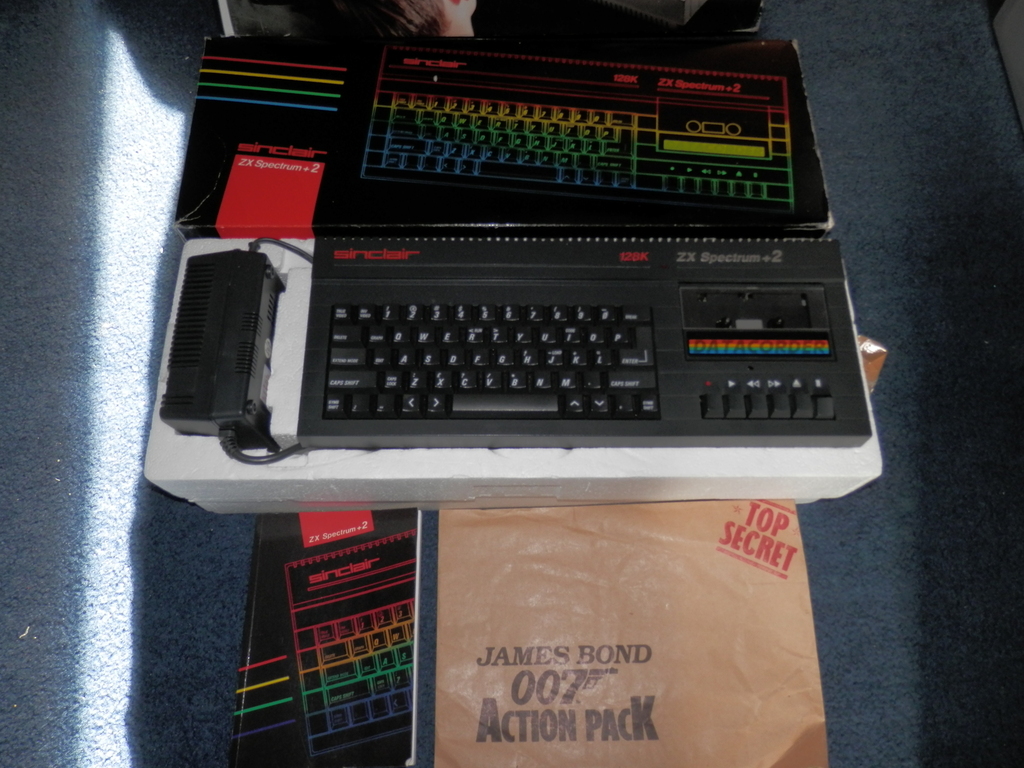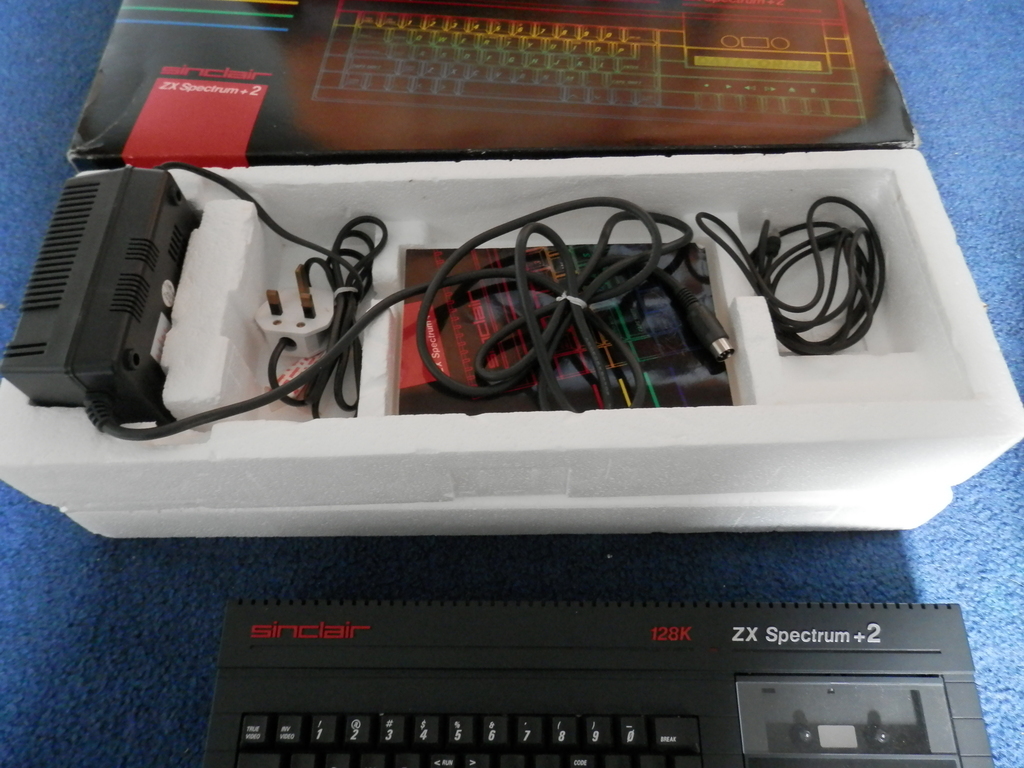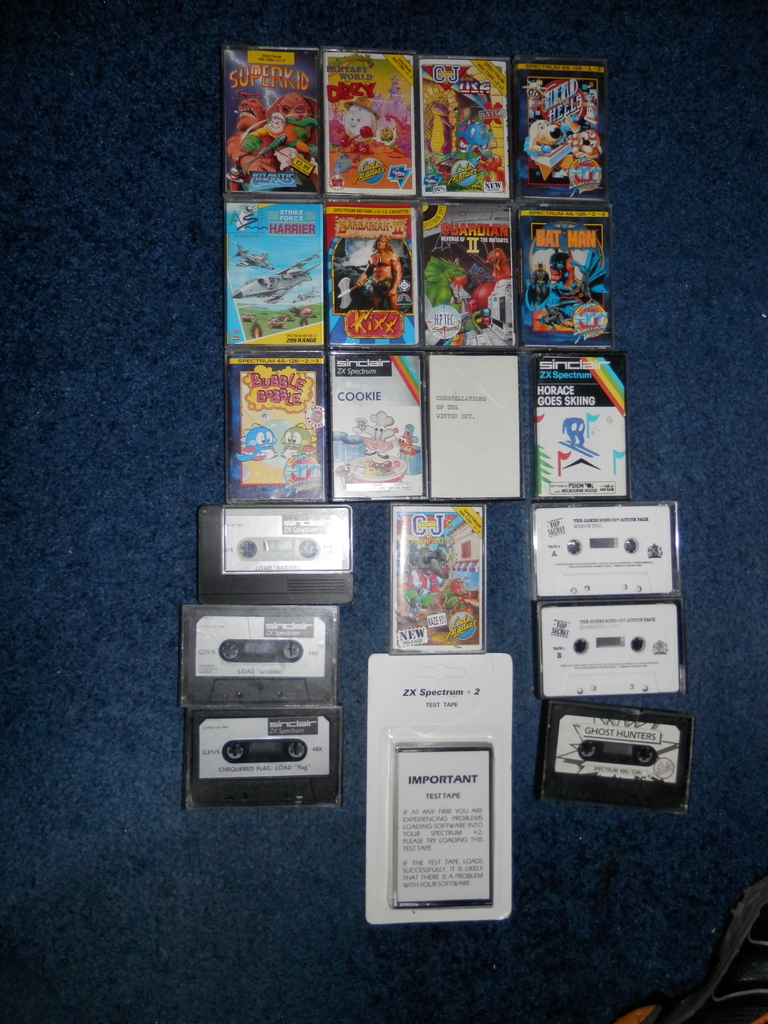"Occasional Distraction" time!
A friend was kind enough to drop this box of goodies off a couple of days ago.

This is well timed as me (and the entire family) have come down with COVID, and I have about as much available energy as a 97 year old who's just run a marathon - so a distraction I could pick away at on and off requiring relatively little physical effort was very welcome.
Inside that box there is a Commodore 64, matching data cassette deck, power supply, couple of games, two joysticks, an original 48K Spectrum and a bunch of cables plus two microphones that are nothing to do with the computers.
I've had a Spectrum for going on 30 years, however it's one that was upgraded with an aftermarket case (and more importantly a real keyboard!) back early in its lifetime. So it doesn't look like a Spectrum. So a factory original one has been on my list for a while.
The Spectrum came up fine with just a wipe down. It's pictured here next to my original one. This wasn't an uncommon retrofit case back in the day, though I can't remember the name of the company that made them right now to save my life.

I always forget when it's been a while since I saw one is how tiny the Spectrum is. The fact that they managed to cram as much capability into such a small unit priced as it was really was quite an achievement at the time I reckon. My original one has a larger case both because it was designed to also house the power supply.
Internally it's a very clean machine. No signs of previous hackery or damage.

Based on the latest date code I can find on anything it looks like this is a machine from the late end of 1984, quite possibly bought as a Christmas gift or in the Boxing day sales.

There are a few scratches on the case but it's perfectly presentable. I like to see all of my machines actually used so I'd rather have one that's presentable but not immaculate to that end. Still an iconic looking thing.

It's the first time I've had a look at a stock machine in forever...I'd not realised that there are several key items on the upgraded keyboard (aside from not feeling as though you're typing on a cheap TV remote) to make your life easier.

First up are dedicated delete, period and comma keys. Those all require shift combinations on the stock one. Likewise dedicated arrow keys, which similarly require a shkft combination normally. Having the symbol shift key duplicated on both sides of the keyboard is useful too. Oh...and an actual space bar, where your brain expects it to be. Still, could be worse - see also ZX80/81 or the sea to TicTacs on the Oric-1.
I've not had a chance to test the Spectrum yet as it didn't come with a power supply and my bench top one currently needs repair due to a duff power switch. I don't have the energy just now to go spelunking in the Box o' Cables (TM) to try to find an alternative 9V DC supply. Will make sure to get it tested soon though.
While the Spectrum was just a little dusty and responded fine to just a good wipe down the C64 was a different story. It was both filthy in general and covered in pen marks. So it was almost immediately pulled apart for cleaning.
Internally it looks to be fine, dusty and there's a little surface rust on the RF modulator case but nothing that concerns me.

Sorry, I totally forgot to get a proper "before" photo so you'll have to make do with ones from just after I'd emptied the case.



The case was then treated to a run though the specialised "parts washer" to get rid of that grime.

Results speak for themselves really. I haven't been able to (even after attacking it with IPA) completely remove the permanent marker line from around the keyboard but it's vastly improved.

A replacement for the missing badge on the case is already on the way.
I would have quite liked to give the key caps the same treatment, however haven't done that for two reasons. Firstly is that they really don't seem inclined to come off. Secondly is that I'm not entirely sure that the silk screened legends for the graphics symbols on the front of the key caps would survive that. So I've just hoovered all the dust out and given it an external scrub down as best I could.
My attention then turned to the cassette recorder. While not as bad as the computer itself it was still pretty grubby.

Especially if you looked closely around the tape counter and the control keys.


The mechanism was a bit dusty and the heads needed a clean but I couldn't see anything wrong. Belts even seem to be absolutely fine. Quite a substantial one compared to anything you'll find these days.

Heads, capstan and pinch roller were given a clean while the case took its turn in the wash.


The grease still seemed to be of the correct consistency so I chose to leave it well alone, just removing any excess lint build up that was stuck to it here and there.
Reassembly was slightly more tricky as it required three tiny little springs and an equally tiny circlip to be put back into their homes, but nothing too drastic.
Cleaned up pretty well.

This is why I tend towards this method for cleaning things where it's viable. There's no way I could ever have got the little recesses like this as clean as this by hand.


The power supply brick will just have to make do with a wipe down as due to the way it's constructed there's no way to disassemble it for a wet clean. A test confirmed that the right voltages were present so we were good to do a test of the system.

Good start. I'm pretty convinced now that there's something amiss with the tuner in this TV as this is the third thing I've fed it an RF signal from in the last few weeks and been rewarded with very poor reception. I'll need to investigate that at a later date. Switching to the composite output run into a monitor via a converter showed a far better image.

Though obviously this is never going to look right on an LCD, it's better than the snowy mess I had before.
Two problems became very quickly apparent. One was that you could crash the system pretty much by breathing anywhere near the power input socket, leading me to believe we had a dry joint on the PCB where the socket attaches. The second problem was that sever keys required several attempts to get to register, the space bar being totally inoperable.
With the symbol shift switch desoldered and around 7500 tiny screws removed it was possible to get into the back of the keyboard. I was quite surprised to find a setup using contact pads on the PCB and conductive rubber pads on the keys rather than a more conventional membrane setup. Not going to complain though as it is a far easier arrangement to clean.

The contacts for the space bar were definitely filthy. No surprise this wasn't working.

Half an hour or so of carefully cleaning the PCB and contact pads with IPA followed.

My suspicion of there being dry solder joints on the power connector was correct. Hard to tell, but there are no less than five in this photo, so they were all reflowed.

I had the sense to test to see if the keyboard was working properly before screwing the case back together.

Success! A fully working keyboard and a system which no longer prone to falling over if you walk across the floor too quickly.
I don't have any C64 software floating around here but there were helpfully two tapes in the box, which both loaded up just fine... though I think I'm going to need something more my speed to do some soak testing.

However I think in the mean time I can declare this system now to be fully working.

My plan is to run a vintage and retro computing panel at an event next year, and thanks to the arrival of these and the BBC Micro a few weeks ago I'm getting pretty close to having most of the machines I'd want to take along in my possession. Some of the calculators and some of the other gear would probably come along too...but the main exhibits will be (Production introduction year in brackets - I can't remember exactly when all mine date from off the top of my head):
[] Apple II (1977).
[] Apple Macintosh SE (1987).
[] BBC Micro (1981).
[] Acorn Electron (1983).
[] Acorn Archimedes A5000 or 7000 - A3000 instead if I can revive it (1991, 1995, 1987).
[] Sinclair ZX Spectrum 48K (1982).
[] Commodore 64 (1982).
[] Amiga A1200 (1992).
[] Toshiba T1200 (1987).
[] Toshiba T3200 (1987).
[] Toshiba T5200 - probably take the T3100e too as the plasma machines always seem to draw a crowd (1991, 1988).
[] Atari ST...there are some numbers there but they could be anything. (Early 90s).
[] Amstrad PPC-512. Because it's just such a bonkers design (1988).
[] Amstrad NC-100 (1992).
[] Psion Series-5 (1997).
[] IBM PS/ValuePoint 433DX/Si - if I rebuild it in time (

?).
[] Compaq Deskpro 386S (I think, reading a very fuzzy photo - haven't collected it yet).
[] Compaq Deskpro P100 - which will likely be hooked up to a mid 90s era projector running a computing history slideshow made in the earliest usable version of PowerPoint I can find. Or I may use the IBM for that - though I'd quite like to have that running OS/2.
There are a couple I'd really like to add to that list that I don't currently own.
[] Sinclair ZX81 - because I sure ain't paying the going rate for a ZX80 these days.
[] Sinclair QL. I've never actually even seen one in person and I doubt I'm the only one. So likely to draw interest. It would be nice to have Sinclair Computers more or less spanning their home computer timeline. Yes I know the QL was more market at businesses, but ya get the idea.
[] Commodore PET. Never going to happen given what they usually go for unless I'm *seriously* lucky. The Apple II is only coming on the scene because a friend has been incredibly generous.
From the calculator side I'd probably bring:
[] CompuCorp 324G Scientist. Sadly non-working, but it's still a real talking point and bloody rare so not many people have seen one (1971).
[] Sharp EL-805 (1973).
[] Sinclair Sovereign (1976).
[] HP 11C and 12C (1981).
[] Texas Instruments TI-66 (1983).
[] Casio PF-3000 (1983).
[] Texas Instruments TI-30 (1976).
[] Sharp EL-8130A (1977).
May just grab a handful more at the time - they at least don't take up too much room.





































 ?).
?).



















